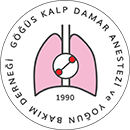

The Effectiveness of Bispectral Index Monitoring on Carotid Endarterectomy with General Anesthesia
Funda Gümüş1, Kerem Erkalp1, Sıtkı N. Şinikoğlu1, Mehmet S. Sevdi1, Abdülkadir Yektaş1, Adil Polat2, Nihan Kayalar2, Ayşin Alagöl11Bagcilar Training And Research Hospital, Anesthesiology And Reanimation Clinic, Istanbul2Bagcilar Training And Research Hospital, Cardiac And Cascular Surgery Clinic, İstanbul
OBJECTIVE: Carotid endarterectomy (CE) is an established treatment in the prevention of cerebrovascular events. A stroke is the most significant perioperative risk for patients undergoing CE secondary to an embolism or carotid cross-clamping. Several cerebral monitoring techniques are available for detection of cerebral hypoperfusion and ischemia during the carotid cross-clamping. The Bispectral index (BIS) is derived from the electroencephalography and may be useful for the diagnosis of perioperative cerebral ischemia This study was aimed to investigate the BIS changes and associated neurological deficitis during carotid cross-clamping in patients under general anesthesia.
METHODS: This study was planned prospectively for patients undergoing elective carotid surgery. Preoperative characteristics were recorded for all patients. The same general anaesthetic protocol and anaesthetic monitorization were performed for all patients. The BIS was used in all patients. BIS measurements were made and recorded at baseline, after induction, at the beginning of surgery, before cross-clamping, at the 1st,2nd,3rd,5th,7th,10th,15th,17th and 20th minutes of clamping and after declamping. The relation of BIS measurements and occurrence of neurologic events were analyzed.
RESULTS: The BIS levels decreased significantly only at the 2nd and 3rd minutes after the clamping (p<0.05). However, BIS measurements increased rapidly afterwards. The BIS measurements did not increase significantly at 1st, 5th, 7th, 10th, 15th, 17th and 20th minutes after clamping. We did not observe any neurological deficit in none of the patients.
CONCLUSION: Several cerebral monitoring modalities are available for carotid surgery. However, none of the monitorization methods of cerebral ischaemia are perfect. Anaesthesiologists should be careful in order to provide sufficient mean arterial pressure for the brain and the heart.
Genel Anestezi ile Karotis Endarterektomi Ameliyatlarında Bispektral İndeks Monitorizasyonunun Etkinliği
Funda Gümüş1, Kerem Erkalp1, Sıtkı N. Şinikoğlu1, Mehmet S. Sevdi1, Abdülkadir Yektaş1, Adil Polat2, Nihan Kayalar2, Ayşin Alagöl11Bağcılar Eğitim Ve Araştırma Hastanesi, Anesteziyoloji Ve Reanimasyon Kliniği, İstanbul2Bağcılar Eğitim Ve Araştırma Hastanesi, Kalp Ve Damar Cerrahisi Kliniği
AMAÇ: Karotis endarterektomileri serebrovasküler olayların engellenmesinde kabul görmüş bir tedavidir. Emboli veya karotis klempinin kullanılması sonucu oluşan inme, karotis endarterektomsi uygulanan hastalarda en önemli perioperatif riski oluşturur. Karotis klempinin uygulanması sırasında oluşan serebral iskemi ve hipoperfüzyon tespiti için kullanılan pek çok serebral monitorizasyon tekniği mevcuttur. Bispektral indeks (BIS), elektroensefalografiden türetilmiştir ve peroperatif serebral iskemi teşhisinde kullanılabilir. Bu çalışmada genel anestezi altındaki olgularda karotis klempi süresince BIS değişikleri ve nörolojik hasar ilişkisi araştırıldı.
YÖNTEMLER: Bu çalışma elektif koşullarda karotis arter cerrahisi geçirecek olgularda prospektif olarak planlandı. Toplam 28 olgunun ameliyat öncesi özellikleri kaydedildi. Olgulara aynı anestezi protokolü ve monitorizasyon uygulandı. Tüm olgulara ameliyat öncesi BIS monitorizasyonu uygulanarak, değerler bazal, indüksiyon sonrası, cerrahi başlangıcı, karotis klempi (KK) öncesi, KKnın 1., 2., 3., 5., 7., 10., 15., 17. ve 20. dk.larda ve KK sonrası olarak kaydedildi. BIS değerleri ve gelişen nörolojik olayların ilişkisi incelendi.
BULGULAR: BIS seviyesi KKnın yalnızca 2 ve 3. dk.larında düştü. Bu azalma istatistiksel olarak anlamlıydı (p<0,05). Ancak takip eden dakikalar içinde hızla yükseldi. Klempin 1., 5., 7., 10., 15., 17. ve 20. dk.larında, klemp öncesi değere göre anlamlı bir fark olmadı. Olgularda nörolojik defisit gözlenmedi.
SONUÇ: Karotis cerrahisi için çeşitli serebral monitorizasyon yöntemleri vardır. Ancak, serebral iskemi tespiti için mükemmel bir monitörden söz etmek mümkün değildir. Anestezist, beyin ve kalp için gerekli ortalama arter basıncının sağlanmasında çok dikkatli olmalıdır.
Manuscript Language: Turkish
(1370 downloaded)

















